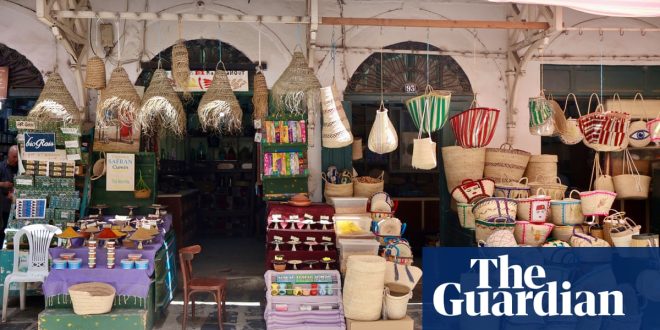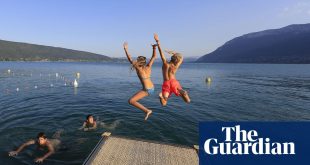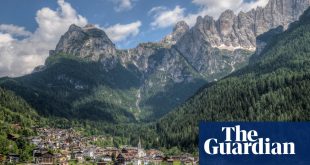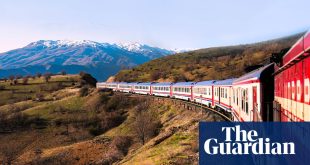The sun is bouncing off whitewashed houses in the bohemian Tunis seaside suburb of La Marsa. It’s Friday lunchtime and I am waiting for Malek Labidi at a smart cafe called Boulevard des Capucines. The rush is building, everyone scurrying around clutching paper-wrapped sandwiches packed full of meat, eggs and fiery harissa. These transportable meals are sold out of hole-in-the-wall establishments and eaten on the go – a practical option in a city where people are so often in a rush.
When Malek arrives, she is greeted by practically everyone in the cafe. A Tunisian chef who trained at the Institut Paul Bocuse in Paris and cut her teeth with Alain Ducasse before returning home, Malek recently released her first cook book, La Table du Nord. Focused on preserving the culinary culture of north Tunisia, it has been lauded for putting the country’s food scene on the map. (It’s available in French only, but see here for a taste of her recipes.) This is particularly important given the tourist drought that hit after the 2011 revolution and the wave of terrorist attacks in the following years. Visitors have started to return though, arriving on ferries from Marseille and Palermo. As we walk down towards the sea, I catch occasional glimpses of flashy cameras and sunburnt limbs – both silent promises to the local economy.
My culinary education begins at Gourmandise La Marsa, a glittering patisserie with shelves lined with cocoa-dusted French gateaux, though we overlook these in favour of the local kaak warka. These miniature doughnut-shaped desserts are made from wild rose water and a soft almond paste. Malek tells me that during the Spanish reconquista of Andalucía, people would make palm-sized kaak warka in order to stuff them with gold. The desserts were smuggled into north Africa, allowing refugees to afford land and build a new home here.
After our snack, we follow the curling road along the seafront. The affluent La Marsa neighbourhood is dotted with artisanal boutiques, coffee shops and upmarket restaurants, and a skatepark further along the coast. At chic clothing store Lyoum, we discover items emblazoned with quirky drawings of harissa tubes and brik – the triangular pastries stuffed with runny egg, potatoes, cheese and tuna. Laughing, Malek says, “We all constantly think about food, even when it comes to fashion.”
We head to beach-front restaurant Le Golfe as the sun dips behind streets lined with trees and enclosed mashrabiya balconies. Le Golfe’s menu is reliant on the Mediterranean and its seasons: in our starter of sea bass carpaccio, the fish is interleaved with thin slivers of beetroot and orange zest. Next, steamed gilt-head bream is served on crispy aubergines and pistachios. We are stuffed to the brim by the time we finish the risotto of john dory, the sweetness of the fish complimented by the buttery simplicity of the sauce. Shuffling in our chairs, we wash our meal down with cups of boukha – a Tunisian fig-flavoured spirit.
Early the next morning, I make my way to the true belly of the city’s food scene – the medina. It’s only 9am but the market is already a place of frantic energy, with shoppers jostling for space between stalls. The medina has a timeworn charm very different from the upmarket boutiques of La Marsa, with sun-drenched leather goods and bunches of dates swinging overhead.
Following Malek’s instructions, I head towards narrow Rue Jamaa Ez Zitouna. Neon lights emblazon its sweet stalls, flickering intermittently above heaps of honey-coated fried dough and date-stuffed pastries. I order a handful of each before heading to Panorama cafe, whose beautifully tiled roof terrace serves bitter Arabic coffee with a perfect view of the Medina, punctuated with the minaret of Zitouna mosque.
After my coffee and pastries, I plunge deeper into the medina. As with most markets, the cheaper trinkets are replaced by authentic items the further in I wander. Traditional handmade red felt caps are piled in towers at the Souk de Chechias, and craft shop Ed-Dar on Rue Sidi ben Arous is selling ornate triangular rugs. Among hardware shops and brash underwear stalls, I find cracked wooden tables heaped with mounds of spices – strands of saffron, earthy ras el hanout and fragrant cinnamon.
Malek, who is working on her second cookbook, has suggested Fondouk El Attarine for lunch. Its lofty doors give way to a peaceful courtyard restaurant sheltered from the noisy market outside, and ravenous from shopping, I order a plate of nwasser au poulet – crispy chicken with pepper-infused sauce and square-shaped Tunisian pasta. Pudding is assida zgougou – pine nut cream topped with crushed pistachio.
after newsletter promotion
The Unesco-protected arty suburb of Sidi Bou Said, known for its blue and white facades, is my next stop. I take my time dipping into contemporary art galleries at Selma Feriani and Galerie Saladin before lounging on the beach until dinner.
Malek meets me in the evening in the seaside suburb of La Goulette, close to the port, whose high street is lined with seafood restaurants. We opt to try the famous fried filo parcels at Chez Mohsen, which styles itself “Roi du Brik”.
Egg yolk soon runs out of my brik on to my plate. This is a cardinal sin according to Malek: tradition has it that only women who can eat this messy delicacy adeptly are ready for marriage. As we part ways later that evening, I vow to continue my Tunisian food tour via her recipe book. Not quite ready for marriage yet, I also make a silent promise to spill the yolk of any prophetic briks that come my way.
 Top Naija News – Nigeria News, Nigerian News & Top Stories Top Naija News – Nigerian Newspapers, Nigerian News. topnaijanews is a daily Nigerian newspaper covering Latest News, Breaking News, Entertainment, Sports, Lifestyle and Politics.
Top Naija News – Nigeria News, Nigerian News & Top Stories Top Naija News – Nigerian Newspapers, Nigerian News. topnaijanews is a daily Nigerian newspaper covering Latest News, Breaking News, Entertainment, Sports, Lifestyle and Politics.




